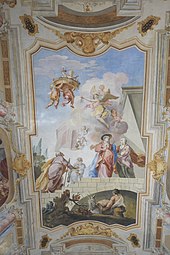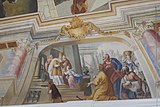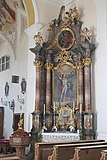Visitation of the Virgin Mary (Gosseltshausen)
The Roman Catholic parish church of the Visitation of the Virgin Mary in Gosseltshausen , a district of the Wolnzach community in the Upper Bavarian district of Pfaffenhofen an der Ilm , is essentially a Gothic building from the late Middle Ages , which was enlarged and rebuilt in the Baroque style at the beginning of the 18th century . The ceilings of the choir and nave are painted with frescoes by Melchior Buchner (1695–1758), which show an impressive pseudo-architecture. The church is one of the protected architectural monuments in Bavaria.
history
From the second half of the 17th century, reconstruction work on the late medieval church building is documented. In 1701, Johann Baptist Zimmermann (1680–1758) created the stucco decoration and the frescoes of the Latin church fathers in the choir as his first work, which, however , were already destroyed when the church burned in 1704 during the War of the Spanish Succession (1701–1714). The church was rebuilt between 1705 and 1721 and refurbished in the following years. In 1752 the painter Melchior Buchner (also Puchner or Büchner) , who came from Schongau and later worked in Ingolstadt, was commissioned to furnish the choir and nave with ceiling frescos. In the course of the regotization of the church in 1874, these frescoes were painted over and the baroque design largely removed. It was not until the renovation in 1905 that the ceiling paintings were exposed and restored. Another interior renovation took place in 2000, and an exterior renovation in 2019.
architecture
Exterior construction
In the northern corner of the choir stands the bell tower, in whose square substructure, framed by arched friezes, is incised from the medieval church building. The tower, which was raised in 1659, has an octagonal structure crowned by a double onion dome with a lantern . The outer wall of the chancel is supported by stepped buttresses reaching up to the height of the windows.
inner space
The interior, a hall building covered with a flattened barrel , is structured by flat pilasters with pieces of entablature over which a profiled, cranked cornice runs. The slightly retracted, two-bay choir is closed on five sides and is vaulted by a needle cap barrel. A gallery with a curved parapet forms the western end of the nave .
chapel
A small chapel with ceiling paintings from around 1720 is added to the south side of the nave. The paintings, which simulate a stucco decoration ( stucco finto ) with bandwork motifs , were exposed again in 1972.
Frescoes
The large choir fresco is dedicated to the Assumption of Mary . The pictures on the side show the marriage of Mary with Joseph , the presentation of Jesus in the temple , the donation of the scapular to St. Simon Stock and the presentation of the rosaries to St. Dominic and St. Catherine of Siena .
The large nave fresco takes up the entire ceiling. The central theme, the Visitation of Mary , relates to the patronage of the church and is embedded in a monumental pseudo-architecture. The pregnant Maria, who is shown with a hat and walking stick, greets her cousin Elisabeth , who had also become pregnant in old age. A circle painted on her body indicates that she will give birth to John the Baptist. The letters IHS are written in a circle on the body of Mary as a sign that she has Jesus within her. On the sides, simulated archways open up views of further scenes from the life of Mary, such as the prediction of the birth of Mary to her parents, St. Anne and St. Joachim (above the gallery), the birth of Mary and her first bath (above the pulpit), Aisle of the Virgin Mary (opposite the pulpit) and the Annunciation (in front of the choir). Under this scene is the Latin inscription: "HANC DILIGE SANCTAM" (love this saint). The letters CDILICM form a chronogram with the year 1752, the year in which the frescoes were made.
In the corners of the nave, framed by medallions, the four Latin church fathers Gregory the Great , Hieronymus , Augustine and Ambrosius of Milan are depicted. Below, four female figures in tone-on-tone painting personify the four continents: Europe is embodied by a woman with a crown and scepter sitting on a horse, a woman with a turban seated on a lion depicts Asia, one dressed in a sun hat Woman sitting on a camel and holding an ear of corn in her hand symbolizes Africa, an Amazon with Indian headgear and a bow and arrow in hand represents America.
pulpit
- The pulpit is a baroque work from 1692. Like the baptismal font, it was acquired from Ismaning . The sound cover is crowned with the figure of John the Baptist . The four evangelists with their symbols and in the middle Christ with the globe are depicted in small shell niches on the pulpit . The door on the back wall of the pulpit, which leads to the pulpit staircase, is decorated with a gold-plated relief of the Ten Commandments . The underside of the pulpit is decorated with angel heads.
Further equipment
- The high altar was installed in 1906, the four large evangelist figures come from the former Reisbach monastery church . The Pietà from the late 17th century, which is surrounded by angel sputtles , takes the place of the altarpiece.
- The two four-column side altars date from the Rococo period . The left altarpiece shows Maria Immaculata , who stands on the crescent moon and crushes the snake's head. The small picture below shows St. Catherine and the extract picture shows St. Barbara . The altar panel of the right side altar shows a guardian angel protecting a child, on the smaller pictures you can see St. Sebastian below and St. Florian above .
- The choir stalls date from the first half of the 18th century.
- The pews, like the confessionals, date from the second half of the 18th century. The latter are decorated with rich Rocailles carvings.
- On the walls of the nave above the twelve apostles chandeliers there are pictures of the apostles painted on wood and framed in oval frames with festoons , which were made in 1790.
- The mount of olives on the north wall of the nave is dated to the first half of the 15th century.
Tombs
In the choir, priest grave stones from the 16th century are set into the wall. In the nave is reminiscent of a large limestone grave plate from 1422, in which an inscription and two arms with crest are engraved on the family of Starz Hauser.
literature
- Georg Dehio : Handbook of the German art monuments. Bayern IV: Munich and Upper Bavaria . 2nd edition, Deutscher Kunstverlag, Munich 2002, ISBN 3-422-03010-7 , pp. 364–365.
- Jolanda Drexler-Herold, Angelika Wegener-Hüssen: Landkreis Pfaffenhofen ad Ilm (= Bavarian State Office for Monument Preservation [Hrsg.]: Monuments in Bavaria . Volume I.19 ). Karl M. Lipp Verlag, Munich 1992, ISBN 3-87490-570-5 , p. 380-383 .
- Przemyslaw Nowak: jewelry box of the Hallertau. The parish church of the Visitation in Gosseltshausen . Catholic Parish Office of the Visitation of the Virgin Mary Gosseltshausen (Ed.), Undated
Web links
- Gosseltshausen Catholic parish community Gosseltshausen
Individual evidence
- ↑ List of monuments for Wolnzach (PDF) at the Bavarian State Office for Monument Preservation, monument number D-1-86-162-49
Coordinates: 48 ° 36 '47.6 " N , 11 ° 36' 32.3" E






















